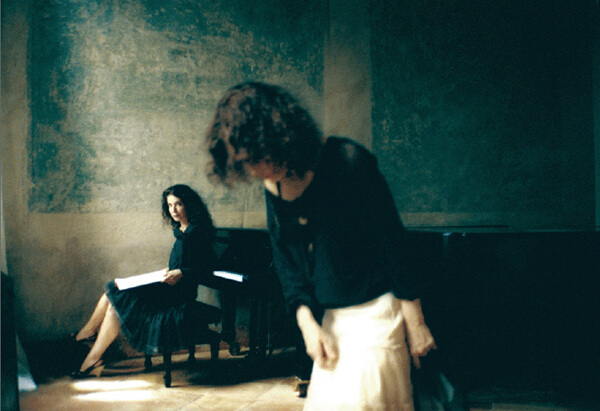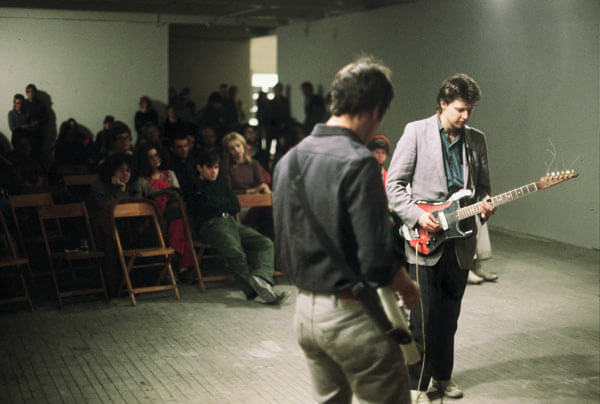

Labèque sisters – Photo by Brigitte Lacombe
The internationally renowned piano duo formed of the sisters Katia and Marielle Labèque led a programme that sought to place popular music as ‘the mother of minimalism’. Laurie Anderson’s O Superman (1981) for tape opened the evening – the sound managed incredibly well in the hall and at the perfect volume. Anderson started life as a sculptor but she established herself in experimental electronic music, particularly after O Superman achieved her so much success, reaching number two in UK popular charts. Toronyi-Lalic’s notes are fascinating and do much to bring this work to life; “Are we meant to read something into the way a warming female voice is dissociated from its origin, mechanized and forced to beat time?”. Marielle followed this work with excerpts from William Duckworth’s Time Curve Preludes (1977-8) and wooed the audience immediately with a beautiful tone and intelligent playing that did much to bring the modality of these pieces to life. A last minute programme change placed Four Movements for Two Pianos (2008) by Glass after the Duckworth and this was a sensible move with what was to follow by Branca. The vibrant Labèque’s gave the Glass its UK premiere and their synergy during performance brought this work to life; the work starts, as Toronyi-Lalic writes, ‘in mid-melodic flight’ and one hears the hallmarks of Glass immediately through cross-rhythms and arpeggio figures. We sensitively conceived slow movement follows and allowed the sisters to display their lyricism and prepared well for the extended third movement. The work ends with a final movement that certainly did end in ‘spectacular style’.

Glenn Branca performing at Hallwalls in the 1980’s. Courtesy of Hallwalls’ archive.
It was a great choice to move the Glenn Branca Lesson No. 1 (1980) to the end of the first half as it was indeed a bold sonic experience but this was never too loud. The rock ensemble featured David Chalmin (guitar), Massimo Pupillo (bass guitar), Raphael Seguiniër (percussion). This was a brilliant choice to end the first half and hear the connections between the aesthetic of the previous works and this engaging study in minimalism for guitars and percussion. The hall seemed to transform into a whole different venue and became exactly what was needed to cater for the strong sound of the ensemble. Terry Riley’s Bird of Paradise (1964) for tape kept those unwilling to leave their seats during the interval company and this is something shockingly modern in sound and remains surprising that it was written nearly 50 years ago.
Riley opened the second half of the concert with Persian Surgery Dervishes (1971) for keyboard performed by Nicola Tescari; it demanded virtuosity in its execution and Tescari delivered. Some programme changes again and placed two more preludes from Duckworth’s Time Curve Preludes together rather than separate as on the programme, and the rock ensemble coloured the piano in both without obliterating the subtlety. Lawrence Chandler’s Music for Rock Ensemble (2011) – performed by the ensemble and the composer on electronics showed the minimalism processes continue to thrive in the ‘symbiotic relationship between minimalism and rock’. Raphael Seguiniër demonstrated his virtuosity as a drummer in the world premiere of his own Free to X (2011) and one was engaged from outset with the obsessive repetition of limited harmonies offset against the additive rhythms in the drums. Aphex Twin’s Avril 14th for piano solo, which followed Nanou2 for piano four hands offered a shard of light in the louder second half and were captivating. Placing Aphex Twin within such a programme showed real insight not only in connecting their approaches with their minimalist forbears but they offset beautifully against the prevailing intensity of the other works. It was great to see the lighting used to colour the performances and Brian Eno’s In Dark Trees (1975) benefited from a subtle change in the ambience.
Oasis. Nah, just kidding. (The Editor)
The programme ended with three songs that showed the richness of David Chalmin’s voice; Baba O’Riley (1971, The Who), Pyramid Song (2001, Radiohead) and Free City Rhymes (2000, Sonic Youth). After hearing the previous items one could connect with ease the minimalist strands that were present in all of these songs and a sense of progression. The audience were indeed incredibly appreciative and were awarded an encore of Suicide’s Ghost rider. Igor Toronyi-Lalic was rightly given a cheer as he joined the performers on stage at the end of the evening – his curation did much to show minimalism is indeed a significant presence in the contemporary music landscape and it remains an utterly compelling style and aesthetic.
—
Steven Berryman is a composer and teacher working and living in London. Follow him on Twitter: @Steven_Berryman
